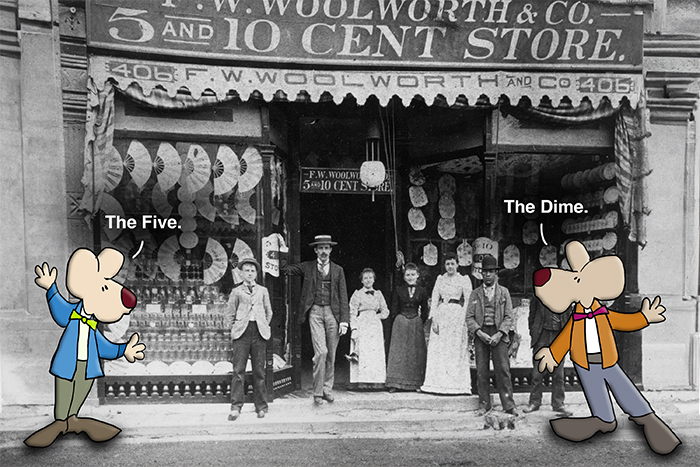I’m getting old. I know this because I miss going to the Woolworths store.
When I was a little girl, there was a shopping plaza not far from our home. Forest Park Shopping Plaza. There were a lot of different stores in that place, including a Liberals Grocery Store, where my mom did the bulk of our grocery shopping, the aforementioned Woolworths, a Ponderosa Steakhouse, and a Putt-Putt Miniature Golf Course, among other things. But of all those places, I’d say the Woolworths was my favorite.
It had a certain smell when you walked through the front door. It gave off a weird combination of hamburger-grilling lunch counter, mixed with various textile odors, with a high note of gerbil cage cedar chips.
Yes, indeed. A beautiful lunch counter and soda fountain were on the left-hand side of the store. The main merchandise was in the center, including a toy section. In the back was the pet shop, which included a variety of fish, gerbils, hamsters, and birds—a dreamy paradise for a six-year-old girl.
Every so often, we’d walk over to the Woolworth’s before or after our visit to Liberals.
Rarely did I get anything from the lunch counter.
Never did I get anything from the pet shop.
But a girl that age was full of longing and dreams.
And I loved walking down all the aisles and running my grimy little hands over all the “stuff.”
(I’ve also written about my Woolworth’s shoplifting incident at age seven with Jana Beckman, where a comedy of errors landed me in the grips of the store manager.). Nonetheless.
I owe all those fond memories to one man: Frank Winfield Woolworth.
Yes. Frank Winfield Woolworth was an American entrepreneur who founded the F. W. Woolworth Company. He began a new concept with the operation of several stores known as “Five-and-Dimes.”
Today, you might have guessed, is his birthday, born on April 13, 1852, in Rodman, New York.
His parents were devout Methodists and sympathetic to the Northern side during the Civil War, and they raised their sons (Frank and his brother Charles) in those beliefs.
At age four, Woolworth told his parents that he would become a peddler like those who sometimes came calling. He and Charles would play “store,” and Frank would set up merchandise to sell to his brother.
He really wanted to live his dream as a peddler. So, in 1873, Frank went to work as a stock boy in a general store called Augsbury & Moore’s Drygoods in Watertown. It turns out he was a terrible salesman for them. But a hard worker. So his boss gave Frank lesser jobs such as washing the windows and sweeping the floors.
That is when he discovered he had a creative bend for arranging the store’s front display. His work was so impressive that his boss assigned him that role full-time.
His way of thinking changed the way shopping was done. You see, clerks used to “retrieve” what the customer wanted. Most of the inventory was kept “behind” the counter. But Frank asserted that “goods should sell themselves.” And this became prominent in his retail career.
I won’t go into all the details about how he borrowed money and started his stores. He hauled a long road, though.
But I will tell you this.
By 1911, the F.W. Woolworth Company was incorporated with 586 stores. In 1913, Woolworth built the Woolworth Building in New York City at a cost of $13.5 million (~$300 million in 2023) in cash. At the time, it was the tallest building in the world at 792 feet.
And then there is this, ironically. I learned that Woolworth often made unannounced visits to his stores, where he would shoplift items to test the staff’s attentiveness. Managers or clerks who caught him doing so were sometimes rewarded with promotions. Maybe I was channeling Frank when I was seven.
It seems like he was a good fellow from afar.
Even so, Woolworth died of septic shock from an infected tooth on April 8, 1919, 5 days before his 67th birthday.
At the time of his death, Woolworth was worth approximately $76.5 million. His company owned more than 1,000 stores in the United States and other countries and was a $65 million corporation. He is buried in the Woodlawn Cemetery in the Bronx, New York City.
And so it went.
I suppose we all have magical places we remember as kids. Woolworths was one of mine. It still holds a certain feel and comfort to it. The minute I walked in through the door, my world was transformed. So. Thanks for that, Mr. Woolworth.
“”””””””””””
“The world is full of magical things, patiently waiting for our senses to grow sharper.” – W.B. Yeats
“”””””””””””
“The most beautiful thing we can experience is the mysterious. It is the source of all true art and science.” – Albert Einstein
“”””””””””””
“Magic is not a practice. It is a living, breathing web of energy that, with our permission, can encase our every action.” – Dorothy Morrison
“”””””””””””
The five. The dime. They had it all.
